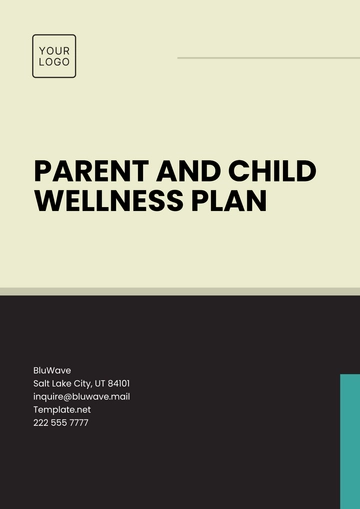Free Community Wellness Layout Plan

Prepared by: [Your Name]
Company: [Your Company Name]
Date: [Insert Date]
I. Introduction
The Community Wellness Plan is a comprehensive approach designed to improve the overall well-being of a community by addressing physical, mental, emotional, and social health. This plan aims to create an environment where community members are empowered to make healthier choices, foster strong relationships, and contribute to collective well-being. By implementing this plan, the community will become more resilient, inclusive, and supportive, encouraging everyone to thrive.
II. Vision and Goals
Vision:
To build a thriving, healthy community where all members are supported, feel connected, and lead fulfilling lives.
Goals:
Promote Physical Health: Encourage healthy lifestyles and regular physical activity for all community members.
Support Mental and Emotional Health: Foster emotional resilience and mental well-being through accessible support systems.
Enhance Social Connectivity: Strengthen community relationships and create a sense of belonging and support.
Promote Healthy Environments: Ensure safe, sustainable, and nurturing spaces for everyone to live and interact.
Encourage Lifelong Learning: Promote opportunities for continuous education and skill-building for personal and professional growth.
III. Key Areas of Focus and Strategies
A. Physical Health and Fitness
Strategies:
Community Exercise Programs: Offer free or low-cost group activities such as yoga, walking clubs, and fitness classes.
Health Education: Provide workshops and seminars on topics such as nutrition, exercise, and preventive healthcare.
Access to Healthcare: Establish free health screening events, vaccination drives, and mental health check-ups to promote regular health monitoring.
Improve Walkability: Enhance infrastructure such as parks, walking trails, and bike lanes to encourage outdoor physical activity.
Support Local Nutrition: Develop community gardens and support local food markets to provide access to healthy food options.
B. Mental and Emotional Health
Strategies:
Mental Health Awareness Campaigns: Provide community-wide educational campaigns to reduce the stigma around mental health and encourage help-seeking behaviors.
Access to Counseling Services: Establish community-based mental health services and counseling centers for individuals and families.
Stress Relief Programs: Organize mindfulness sessions, meditation workshops, and relaxation techniques to help manage stress.
Community Support Groups: Facilitate peer-led support groups focusing on various issues such as addiction, grief, and anxiety.
Promote Emotional Intelligence: Offer workshops on communication, conflict resolution, and emotional regulation to help people manage relationships more effectively.
C. Social Connectivity and Relationships
Strategies:
Community Events: Host regular events such as fairs, potlucks, and festivals to bring people together and celebrate the community's diversity.
Volunteer Opportunities: Create platforms for members to volunteer, fostering a sense of purpose and community spirit.
Neighborhood Watch Programs: Establish programs that promote safety, trust, and cooperation among neighbors.
Family Support Programs: Offer family counseling, parenting classes, and support networks to strengthen family relationships.
Intergenerational Activities: Encourage activities that bring together people of different age groups to foster mutual understanding and connection.
D. Healthy Environments
Strategies:
Environmental Sustainability: Promote eco-friendly practices such as recycling programs, tree planting initiatives, and reducing carbon footprints.
Safe Public Spaces: Ensure all parks, streets, and community centers are well-lit, safe, and accessible to all members, including those with disabilities.
Affordable Housing: Advocate for policies that ensure access to affordable, safe housing for all community members.
Green Spaces: Develop more green spaces within urban areas to provide opportunities for relaxation, play, and community gatherings.
Healthy Building Initiatives: Encourage local businesses and housing developments to use sustainable, energy-efficient building materials.
E. Lifelong Learning and Personal Growth
Strategies:
Skill-Building Workshops: Offer free or affordable workshops on financial literacy, digital skills, entrepreneurship, and other relevant topics.
Adult Education Programs: Provide access to adult education courses, including GED programs, language learning, and vocational training.
Youth Development: Implement mentorship programs, after-school clubs, and extracurricular activities to support the development of young people.
Job Training and Placement: Partner with local businesses and educational institutions to create job readiness programs and internships for community members.
Promote Reading and Literacy: Establish community libraries, reading clubs, and storytelling events to cultivate a love for learning.
IV. Implementation Plan
A. Roles and Responsibilities
Community Leaders: Provide leadership and oversee the implementation of the plan. They will advocate for resources and encourage participation.
Community Members: Actively engage in wellness activities, provide feedback, and support one another’s well-being.
Local Organizations and Partners: Collaborate to provide specialized services such as health screenings, mental health counseling, and educational programs.
Government and Policy Makers: Support with necessary legislation, funding, and infrastructure development to create an enabling environment for wellness.
B. Timeline
Phase 1 (Month 1-3): Launch awareness campaigns, establish wellness programs, and begin community health assessments.
Phase 2 (Month 4-6): Begin physical health activities, initiate mental health workshops, and establish community support groups.
Phase 3 (Month 7-12): Expand programs, host community events, and assess early outcomes.
Ongoing: Regularly evaluate progress, refine initiatives, and ensure the plan evolves with the community's needs.
V. Measurement and Evaluation
A. Key Performance Indicators (KPIs)
Community Engagement: Measure participation rates in events, workshops, and wellness activities.
Health Outcomes: Track improvements in physical and mental health metrics, such as reduced stress levels, increased physical activity, and lower rates of chronic illness.
Social Connectivity: Assess the number of community members participating in social and volunteer activities.
Satisfaction: Conduct surveys to gauge the satisfaction of community members with the wellness programs and initiatives.
Sustainability: Evaluate the long-term sustainability of programs, particularly those focused on environmental sustainability and social support.
B. Evaluation Methods
Surveys and Feedback: Collect regular feedback from community members to assess program effectiveness and identify areas for improvement.
Focus Groups: Hold focus group discussions to delve deeper into community experiences with wellness programs.
Data Tracking: Utilize health data, participation records, and other metrics to monitor the success of specific strategies.
Annual Review: Conduct an annual review to evaluate overall progress, challenges, and successes.
VI. Sustainability Plan
Community Ownership: Foster a sense of ownership by encouraging community leaders and members to take leadership roles in wellness initiatives.
Long-Term Partnerships: Establish partnerships with local businesses, government agencies, and non-profits to ensure long-term support for wellness programs.
Ongoing Education: Provide continuous education on health and wellness topics to ensure that community members remain informed and motivated.
Flexible Programs: Adapt programs as necessary to meet the changing needs of the community, especially in response to emerging challenges or opportunities.
VII. Conclusion
The Community Wellness Plan aims to create an environment that supports the holistic well-being of all community members. By addressing physical, mental, emotional, and social health, the plan will foster stronger connections, promote healthier lifestyles, and improve the overall quality of life for everyone involved. The success of this plan will rely on active participation, continuous evaluation, and collaboration among all community stakeholders. Together, we can build a community that is healthier, more connected, and better equipped to thrive.
- 100% Customizable, free editor
- Access 1 Million+ Templates, photo’s & graphics
- Download or share as a template
- Click and replace photos, graphics, text, backgrounds
- Resize, crop, AI write & more
- Access advanced editor
You may also like
- Finance Plan
- Construction Plan
- Sales Plan
- Development Plan
- Career Plan
- Budget Plan
- HR Plan
- Education Plan
- Transition Plan
- Work Plan
- Training Plan
- Communication Plan
- Operation Plan
- Health And Safety Plan
- Strategy Plan
- Professional Development Plan
- Advertising Plan
- Risk Management Plan
- Restaurant Plan
- School Plan
- Nursing Home Patient Care Plan
- Nursing Care Plan
- Plan Event
- Startup Plan
- Social Media Plan
- Staffing Plan
- Annual Plan
- Content Plan
- Payment Plan
- Implementation Plan
- Hotel Plan
- Workout Plan
- Accounting Plan
- Campaign Plan
- Essay Plan
- 30 60 90 Day Plan
- Research Plan
- Recruitment Plan
- 90 Day Plan
- Quarterly Plan
- Emergency Plan
- 5 Year Plan
- Gym Plan
- Personal Plan
- IT and Software Plan
- Treatment Plan
- Real Estate Plan
- Law Firm Plan
- Healthcare Plan
- Improvement Plan
- Media Plan
- 5 Year Business Plan
- Learning Plan
- Marketing Campaign Plan
- Travel Agency Plan
- Cleaning Services Plan
- Interior Design Plan
- Performance Plan
- PR Plan
- Birth Plan
- Life Plan
- SEO Plan
- Disaster Recovery Plan
- Continuity Plan
- Launch Plan
- Legal Plan
- Behavior Plan
- Performance Improvement Plan
- Salon Plan
- Security Plan
- Security Management Plan
- Employee Development Plan
- Quality Plan
- Service Improvement Plan
- Growth Plan
- Incident Response Plan
- Basketball Plan
- Emergency Action Plan
- Product Launch Plan
- Spa Plan
- Employee Training Plan
- Data Analysis Plan
- Employee Action Plan
- Territory Plan
- Audit Plan
- Classroom Plan
- Activity Plan
- Parenting Plan
- Care Plan
- Project Execution Plan
- Exercise Plan
- Internship Plan
- Software Development Plan
- Continuous Improvement Plan
- Leave Plan
- 90 Day Sales Plan
- Advertising Agency Plan
- Employee Transition Plan
- Smart Action Plan
- Workplace Safety Plan
- Behavior Change Plan
- Contingency Plan
- Continuity of Operations Plan
- Health Plan
- Quality Control Plan
- Self Plan
- Sports Development Plan
- Change Management Plan
- Ecommerce Plan
- Personal Financial Plan
- Process Improvement Plan
- 30-60-90 Day Sales Plan
- Crisis Management Plan
- Engagement Plan
- Execution Plan
- Pandemic Plan
- Quality Assurance Plan
- Service Continuity Plan
- Agile Project Plan
- Fundraising Plan
- Job Transition Plan
- Asset Maintenance Plan
- Maintenance Plan
- Software Test Plan
- Staff Training and Development Plan
- 3 Year Plan
- Brand Activation Plan
- Release Plan
- Resource Plan
- Risk Mitigation Plan
- Teacher Plan
- 30 60 90 Day Plan for New Manager
- Food Safety Plan
- Food Truck Plan
- Hiring Plan
- Quality Management Plan
- Wellness Plan
- Behavior Intervention Plan
- Bonus Plan
- Investment Plan
- Maternity Leave Plan
- Pandemic Response Plan
- Succession Planning
- Coaching Plan
- Configuration Management Plan
- Remote Work Plan
- Self Care Plan
- Teaching Plan
- 100-Day Plan
- HACCP Plan
- Student Plan
- Sustainability Plan
- 30 60 90 Day Plan for Interview
- Access Plan
- Site Specific Safety Plan





























